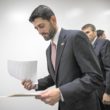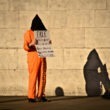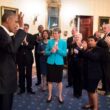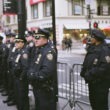She composed herself, told me to read Ross Sorkin’s article in the Times, and turned her attention to the two young women leading the general assembly.
After watching this movement from up close for two days in October, as well as from afar, I find myself in agreement with the government regulator who feels compelled to spend her evenings with the Occupy Wall Street (OWS) activists.
Something is happening here: a critically important attempt to hold unaccountable power accountable.
This is a movement that only began on September 17, as a response to an ad in Adbusters, a Vancouver, British Columbia, magazine. The image on the ad is a dancer, elegantly poised on the back of the Wall Street Bull statue in the Financial District. The text reads: What is our one demand? #Occupy Wall Street. September 17th. Bring Tent.
One hundred fifty people showed up the first day. Then many more. Students who see a diminished future, recent college graduates who can neither find work nor start paying off their student loans, chronically unemployed. In other words, surplus people, rendered unnecessary by an economy that no longer works and activists supporting them.
At 7:30 p.m. on October 4, two young women were addressing a general assembly of more than 200, while another 100 listened to music in the west end of the park.
Because electronic amplification is prohibited, Occupy Wall Street organizers have devised a system that positions “human microphones” within hearing distance of those speaking, to relay what is said to those too far away to hear. At times everyone standing near the speaker repeats what was said, which results in a polyphonic fugue that is both maddening and compelling.
The assembly began with one of the facilitators describing the ground rules, then demonstrating hand gestures participants use to indicate agreement, disagreement, the need for a speaker to wrap it up, a point of information, a question.
Then she laid out an agenda that included working proposals, report-backs from working groups, general announcements, and individual remarks.
There’s obviously a lot of organizational work behind these general assemblies. I asked a man sitting at the press center on the south side of the park how it happens. “Everything is done by consensus,” he said. “In working groups.”
The two women running the assembly, he explained, are part of a facilitation working group. Before the two-hour assembly concluded, we heard from representatives from a medical group, a security group, an outreach group, and a media group.
Someone in some working group has even devised a process that corrects the singular, endemic problem that drains the life from demonstrations on the political left: the endless, stultifying, repetitive ideological speech.
At the beginning of the assembly, one of the facilitators, a young Asian woman, announced that anyone can speak. But there’s a process, she said. “Give your name to the stack-keeper and he will call on so you can get on stack.”
The stack-keeper is a gatekeeper, calling on individuals to come to the front of the assembly to get “on stack” to speak. Preference is given to women and minorities of color and disability. On paper, the process appears precious and contrived. And it is easily caricatured by critics on the right. On the ground, it is remarkably effective.
The item that dominated the October 4 agenda was a march the following afternoon, from Zuccotti Park (formerly Liberty Plaza Park) to Foley Square.
“Tomorrow is a big day for us,” the facilitator said.
A member of the security group said that in response to a proposal voted out at the morning general assembly (there are two a day), the security group had contracted with a private firm “to train our volunteers to properly handle any situation that involves us and the NYPD.”
He described a system of color codes: red for blood, blue for a fight, green for drugs, and white for a thief. Members of the security group, he said, will be recognizable by their armbands, as will members of the medical group.
The following afternoon I joined a group of 50 nurses from National Nurses United, who jumped the gun and headed north on Broadway before the march officially started.
A crowd estimated at 20,000 was behind us, much of it organized labor: the United Federation of Teachers, the Transport Workers Union, the Communications Workers of America, the Service Employees International Union, the American Federation of State, County and Municipal Employees, the Hotel Employees and Restaurant Employees union, and others who have found their way to a movement that began with an ad in an obscure Canadian magazine.
The Occupy Wall Street movement has yet to define a specific agenda. “That will come later,” said New School economics professor Richard Wolff at the evening speaker’ s forum at the southeast corner of the park.
“Right now, we’re building.”
BUILDING “Television is a hot medium that can make a crowd look like a mob,” Larry Goodwyn said in a phone interview. Goodwyn is a retired professor of history, and author of The Populist Moment. His observations on the media and mass movements are informed by his participation in the civil rights movement.
Television coverage of the Wall Street protest has made it easier for the right – Newt Gingrich, Eric Cantor, Herman Cain – to turn up the heat, as they try to cast the OWS movement as a threat to civil society.
They are wrong.
The protestors in Zuccotti Park are totally unlike the masked anarchists of the 1999 World Trade Organization protests in Seattle. A Google image search will confirm that this is a diverse mix of students and activists. A youthful crowd with a low freak-factor; the cultural radicals who set the conventional middle class on edge are underrepresented.
And this is a movement that has built its own infrastructure. By their second week in the park, the organizers had created their own printing press, cafeteria line, communications center with Internet access, legal-services office, and administrative center.
All completely open to anyone who would join the movement. All supported by donations of food, money, and services through a website, https://occupywallst.org, that even allows supporters to donate money, laundry, and showers if they live nearby, or food from Panini & Co. on lower Broadway, which is taking phone orders.
And it is “cloaked in civility.”
At one point during the October 4 general assembly, a speaker from the security group reminded protestors to avoid congregating in front of food carts in the park, so that merchants could continue to do business.
THE 99 PERCENT What turned a small park on lower Broadway into a protest encampment, and put 20,000 people on the streets of Lower Manhattan?
The unifying principle that binds the disparate collective together is the inequitable distribution of wealth between the 1 percent at the top and the other 99 percent.
Although Columbia University professor Joseph Stiglitz is not a part of the Occupy Wall Street movement, he has been writing and speaking about the grievances that the “99 Percenters” have taken to the streets of New York.
Stiglitz spoke at the evening forum in Zuccotti Park on October 2, when he compared the protestors to Los Indignados, the popular movement that has brought hundreds of thousands of unemployed young people into the streets and plazas of Spain.
It was a brief talkmost notable because Stiglitz departed from his economics script to tell the protesters that in a democratic society they “should have the right to walk down the street peacefully and demonstrate their views, and not be sprayed with pepper spray.”
Writing in Vanity Fair in May 2011, Stiglitz described in greater detail the economic realities that now drive this movement: “The upper 1 percent of Americans are now taking in a quarter of the nation’s income every year. In terms of wealth rather than income, the top 1 percent control 40 percent. Twenty-five years ago the corresponding figures were 12 percent and 33 percent…. While the top 1 percent have seen their incomes rise 18 percent over the past decade, those in the middle have actually seen their incomes fall.”
As a consequence, the United States now compares to Russia and Iran in income inequality. And the wealth gap continues to grow even as the top 1 percent’ s share of the national income is larger today than in any other time since the Great Depression.
Stiglitz cited several causes of income inequality: a worldwide global marketplace that pits low-wage workers abroad against unskilled workers at home, labor-saving technologies, the decline of unions.
And he touched on a few policy decisions that have made the income gap and wealth gap greater. Lowering the tax rates on capital gains, where the rich receive much of their income, has concentrated wealth.
Regulators who programmatically ignore laws put in place to make the economy work for everyone have also contributed to greater inequity.
“Lax enforcement of anti-trust laws,” Stiglitz wrote, “especially during Republican administrations, has been a godsend to the top 1 percent.”
This is not the economic theory that earned Stiglitz the Nobel Prize, but rather Economics of Inequality 101.
GREAT EXPECTATIONS Even if, as Stiglitz writes, income disparity increased most when Republican presidents were in office, it required the election of Barack Obama to make this movement happen.
The economy had collapsed months before Obama took the oath of office in January 2009.
The $700 billion Troubled Asset Relief Program (TARP) was passed by Congress on October 3, 2008, three days after an initial House vote rejected it 228–205, sending the Dow Jones Industrial Average into a 700-point declinethe biggest one-day loss ever.
The value of homeswhere most Americans build most of the equity they will ever own had fallen by 30 percent.
At least $8.4 trillion had been wiped off the value of American stocks, as people saw their retirement accounts reduced by a third or more.
Lehman Brothers, an investment house founded before the Civil War, was gone, after the largest bankruptcy filing in U.S. history wiped out its shareholders and left creditors in line to collect pennies on the dollar.
The government had seized control of American International Group, extending an $85 billion loan that gave American taxpayers a 79 percent equity stake in the world’s biggest insurer.
This occurred in the administration of George W. Bush, who believed that markets should be left to regulate themselves.
Ardent Obama supporters believed their new president would resurrect the economy by summer. Outside that circle, in the reality-based culture, there was an expectation that help had arrived. And that the corporate executives who had destroyed the economy would be held accountable.
I recall the kinetic energy at a House Financial Services Committee hearing on February 11, 2009.
The eight C.E.O.s whose banks had pushed the world into recession did a perp walk into the hearing room: Jamie Dimon of JPMorgan Chase, Citi’s Vikram Pandit, Lloyd Blankfein from Goldman Sachs, et al.
America’s Most Wanted C.E.O.s, under oath and seated at the same witness table.
There was predictable ideological claptrap, such as Alabama Republican Spencer Bachus’ s indictment of Congress and defense of the bankers:
“Gentleman, we in Congress, I think, have screwed up health care pretty badly, and K-through-12, through our involvement. And now we’re turning our attention to
you. May god help us, and help you, and all the American people as we do that.” Bachus now chairs the Financial Services Committee. But when Congress convened in 2009, he and other minority members on the committee were outnumbered, as the majority party defined the agenda.
DEMOCRATIC SKEPTICS California Democrat Brad Sherman demanded an accounting of TARP money that had been paid as dividends to shareholders and bonuses to executives.
“Gentlemen, money is fungible,” Sherman said. “It’s a rather silly claim to say, ‘[W]ell, we just used the depositors’ money or the investors’ money to pay the dividends or bonuses, and then we put the taxpayers’ money in our vault.'”
New York Democrat Gary Ackerman wanted the bank executives to explain why, despite their assurances that they were making loans, his constituents couldn’t get home loans, refinance their homes, buy automobiles, or borrow money to send their children to college.
But what takes me back to a hearing held almost three years ago was Massachusetts Congressman Michael Capuano’s questions, which began with the structured investment vehicles that allowed bankers to borrow money as low-interest short-term securities and lend it at long-term high-interest rates.
“[T]he SIVs, to me, are illegal,” Capuano said. “But then we’ve had no prosecutorial action at all from the last administration. And the new administration has had little time to figure this out. We’ll find out if anybody cares.”
The answer to the question that Capuano framed in his last sentence is what moved thousands of people to respond to an ad that read “Occupy Wall Street…Bring Tent.”
Nobody cares.
Members of Congress might subject the eight perpetrators of the largest bank heist in history to a ritual public humiliation. But at the end of the day, and the end of each subsequent year, the bankers remain unaccountable.
The people camped in the center of the Financial District are looking for a way to make them accountable.






0 Comments